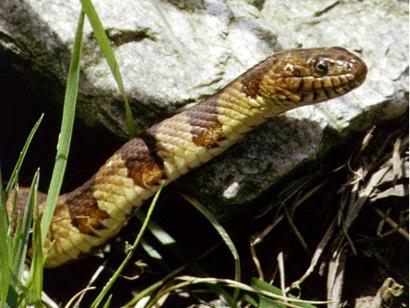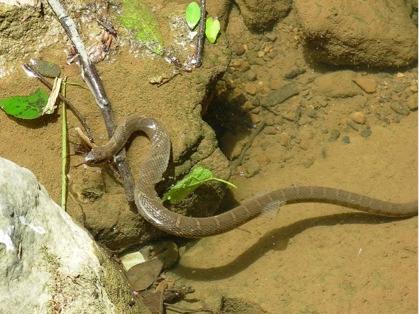Northern Watersnakes
-
Scientific Name
Nerodia sipedon - Visit ITIS for full scientific classification.
-
Description
 Norhern watersnake. © Patrick Coin. (commons.wikimedia.org)
Norhern watersnake. © Patrick Coin. (commons.wikimedia.org) Northern watersnake. © Sean Gagnon. (commons.wikimedia.org)
Northern watersnake. © Sean Gagnon. (commons.wikimedia.org)- Dark-colored, heavy-bodied snakes.
- Four subspecies: Lake Erie, Midland, Carolina, and Common.
- Usually a tan, brown, or gray color with black, dark brown, or reddish colored crossbands.
- White or yellowish colored bellies with dark half-moon shaped markings.
- Possible for individuals to get up to 4.5 feet long.
- Males are usually smaller than females.
- Not a venomous snake, but they do bite and can discharge a musky, foul-smelling substance when threatened.
-
Habitat
- Found in a wide variety of freshwater habitats including: ponds, lakes, ditches, streams, rivers, etc.
- Prefers sunny locations, and shallow waters for basking.
- When not basking, they are found hiding under rocks, driftwood, debris, or other natural or man-made structures.
-
Invasion Pathways and Distribution
- Watersnakes make poor pets, but are still found in the pet trade.
- Therefore, the most likely pathway of introduction to non-native areas is release from pet owners.
- Native to Eastern U.S.
- Now found in some areas of California.
- See USGS for a map of current U.S. distribution.
-
Life History
- Mating can take place on land or in the water, and usually occurs in the spring.
- Mothers retain eggs internally and give birth to live young in the summer.
- Sexual maturity occurs at around 2 or 3 years of age.
- Average lifespan in the wild is unknown, but an individual in captivity was reported to live almost 10 years.
-
Impacts
- Predators that feed on fish, amphibians, and invertebrates.
- Established populations of Northern Watersnakes could decrease the number of native species due to predation.
- Also, increased numbers could threaten California's native garter snakes through direct competition.
-
References and Useful Links
For references by category and links to other useful AIS sites see our Learn More page.


